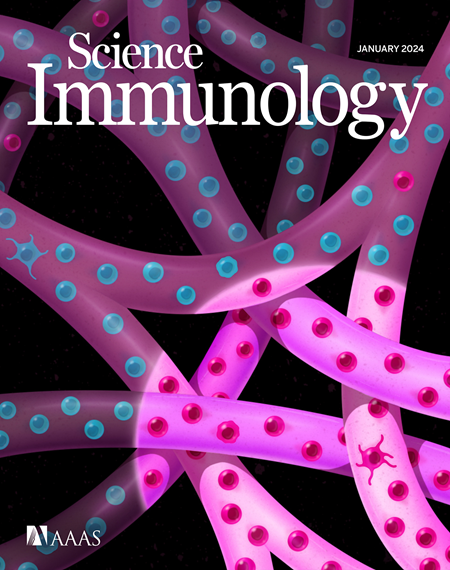HDAC3 整合了 TGF-β 和微生物线索,对粘膜免疫监测中的簇细胞生物生成和昼夜节律进行编程
IF 17.6
1区 医学
Q1 IMMUNOLOGY
引用次数: 0
摘要
肠道粘膜表面直接暴露在由 24 小时光照和进食周期驱动的食物和微生物的日波动中。肠上皮簇细胞是监视肠腔环境的关键哨兵,但这些细胞如何进行昼夜编程仍是未知数。在这里,我们发现组蛋白去乙酰化酶 3(HDAC3)控制着簇细胞的规格及其生物生成的昼夜节律,而昼夜节律受肠道微生物群和进食时间的调节。上皮细胞 HDAC3 的破坏会减少簇细胞的数量,从而影响抗蠕虫免疫和诺如病毒感染。从机理上讲,HDAC3的非典型功能是激活转化生长因子-β(TGF-β)信号,从而促进Pou2f3的节律性表达,Pou2f3是簇细胞的线型定义转录因子。我们的研究结果揭示了环境与表观遗传学之间的联系,这种联系控制着簇细胞的昼夜分化,并促进有节律的粘膜监控和免疫反应,以应对外源挑战。本文章由计算机程序翻译,如有差异,请以英文原文为准。
HDAC3 integrates TGF-β and microbial cues to program tuft cell biogenesis and diurnal rhythms in mucosal immune surveillance
The intestinal mucosal surface is directly exposed to daily fluctuations in food and microbes driven by 24-hour light and feeding cycles. Intestinal epithelial tuft cells are key sentinels that surveil the gut luminal environment, but how these cells are diurnally programmed remains unknown. Here, we show that histone deacetylase 3 (HDAC3) controls tuft cell specification and the diurnal rhythm of its biogenesis, which is regulated by the gut microbiota and feeding schedule. Disruption of epithelial HDAC3 decreases tuft cell numbers, impairing antihelminth immunity and norovirus infection. Mechanistically, HDAC3 functions noncanonically to activate transforming growth factor–β (TGF-β) signaling, which promotes rhythmic expression of Pou2f3, a lineage-defining transcription factor of tuft cells. Our findings reveal an environmental-epigenetic link that controls the diurnal differentiation of tuft cells and promotes rhythmic mucosal surveillance and immune responses in anticipation of exogenous challenges.
求助全文
通过发布文献求助,成功后即可免费获取论文全文。
去求助
来源期刊

Science Immunology
Immunology and Microbiology-Immunology
CiteScore
32.90
自引率
2.00%
发文量
183
期刊介绍:
Science Immunology is a peer-reviewed journal that publishes original research articles in the field of immunology. The journal encourages the submission of research findings from all areas of immunology, including studies on innate and adaptive immunity, immune cell development and differentiation, immunogenomics, systems immunology, structural immunology, antigen presentation, immunometabolism, and mucosal immunology. Additionally, the journal covers research on immune contributions to health and disease, such as host defense, inflammation, cancer immunology, autoimmunity, allergy, transplantation, and immunodeficiency. Science Immunology maintains the same high-quality standard as other journals in the Science family and aims to facilitate understanding of the immune system by showcasing innovative advances in immunology research from all organisms and model systems, including humans.
 求助内容:
求助内容: 应助结果提醒方式:
应助结果提醒方式:


